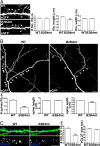Impaired maturation of dendritic spines without disorganization of cortical cell layers in mice lacking NRG1/ErbB signaling in the central nervous system
- PMID: 19240213
- PMCID: PMC2657442
- DOI: 10.1073/pnas.0900355106
Impaired maturation of dendritic spines without disorganization of cortical cell layers in mice lacking NRG1/ErbB signaling in the central nervous system
Abstract
Neuregulin-1 (NRG1) and its ErbB2/B4 receptors are encoded by candidate susceptibility genes for schizophrenia, yet the essential functions of NRG1 signaling in the CNS are still unclear. Using CRE/LOX technology, we have inactivated ErbB2/B4-mediated NRG1 signaling specifically in the CNS. In contrast to expectations, cell layers in the cerebral cortex, hippocampus, and cerebellum develop normally in the mutant mice. Instead, loss of ErbB2/B4 impairs dendritic spine maturation and perturbs interactions of postsynaptic scaffold proteins with glutamate receptors. Conversely, increased NRG1 levels promote spine maturation. ErbB2/B4-deficient mice show increased aggression and reduced prepulse inhibition. Treatment with the antipsychotic drug clozapine reverses the behavioral and spine defects. We conclude that ErbB2/B4-mediated NRG1 signaling modulates dendritic spine maturation, and that defects at glutamatergic synapses likely contribute to the behavioral abnormalities in ErbB2/B4-deficient mice.
Conflict of interest statement
The authors declare no conflict of interest.
Figures






References
-
- Gassmann M, et al. Aberrant neural and cardiac development in mice lacking the ErbB4 neuregulin receptor. Nature. 1995;378:390–394. - PubMed
-
- Lee KF, et al. Requirement for neuregulin receptor erbB2 in neural and cardiac development. Nature. 1995;378:394–398. - PubMed
-
- Meyer D, Birchmeier C. Multiple essential functions of neuregulin in development. Nature. 1995;378:386–390. - PubMed
Publication types
MeSH terms
Substances
Grants and funding
LinkOut - more resources
Full Text Sources
Molecular Biology Databases
Research Materials
Miscellaneous

